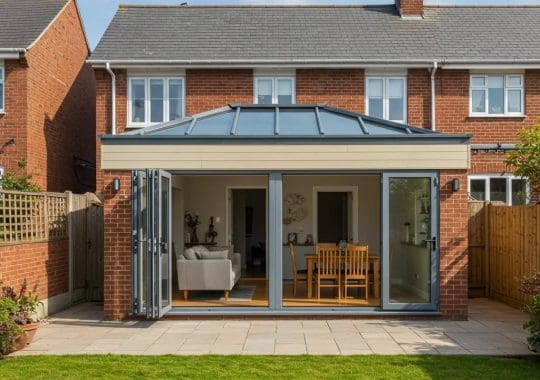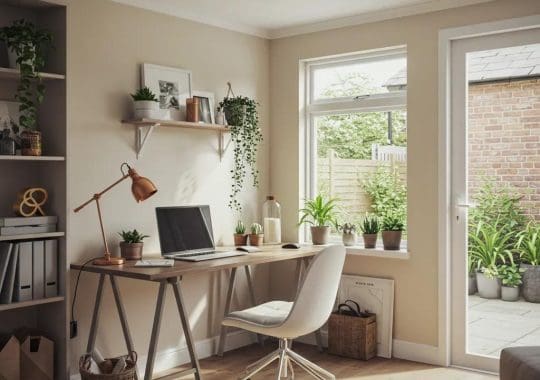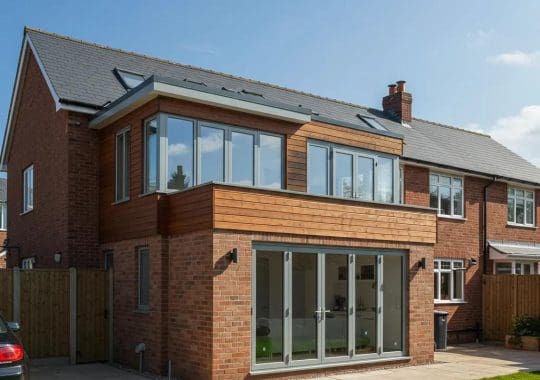Navigating Planning Permissions for Cardiff Homeowners
Did you know that a significant number of home improvement projects in Cardiff encounter delays simply because of overlooked planning requirements?
Beat the Planning Hurdles in Cardiff: Expert Insights for 2025
This article points out that developers in Cardiff frequently face planning-related delays, which can significantly extend construction schedules and inflate project costs. The primary culprits behind these holdups include incomplete application documents, insufficient design specifics, and a lack of proactive engagement with the council before submitting plans.
Getting a firm grasp on planning permission in Cardiff empowers homeowners to ensure compliance, minimise potential risks, and smooth out the building process. This comprehensive guide will walk you through what planning permission entails, how permitted development rights function, the application process with Cardiff Council, specific regulations for extensions, loft and garage conversions, considerations for conservation areas and listed buildings, the appeals process, and when it’s wise to bring in planning consultants or architects.
Understanding Planning Permission: Why It Matters for Cardiff Homeowners
Planning permission is the official go-ahead from Cardiff Council, confirming that your proposed building works align with local development strategies and national building standards. Its purpose is to safeguard our heritage, preserve the character of our neighbourhoods, and protect our environment. For instance, proceeding with a two-storey extension without the necessary consent could result in an enforcement notice demanding its removal.
By obtaining the correct planning permission, homeowners contribute to Cardiff‘s safe and sustainable development while sidestepping potential legal repercussions.
Housing Pipeline Report Q4 2024
The Home Builders Federation‘s Housing Pipeline Reports, compiled using data from Glenigan, reveal a substantial and ongoing downturn in the number of planning permissions granted for new housing sites and units across England, hitting historic lows. This trend is largely attributed to an environment that discourages development, a shortage of planning professionals within local authority departments, and wider systemic issues impacting housing supply.
Securing this approval also provides clarity on design parameters and ensures your project aligns with the objectives outlined in the Local Development Plan.
What Aspects Does Planning Permission Cover in Cardiff?
In Cardiff, planning permission governs new constructions, extensions, external modifications, changes in property use, and demolition. It specifically regulates:
- The building’s footprint and overall height
- The choice of materials and how the design integrates with the surroundings
- Transitions from residential use to commercial purposes or Houses in Multiple Occupation (HMO)
These controls are in place to ensure that all developments contribute positively to the goals of Cardiff‘s Local Development Plan and uphold community standards, paving the way for responsible neighbourhood evolution.
Cardiff Council's Approach to Managing Planning Applications
Cardiff Council evaluates planning applications by assessing their compliance with the Local Development Plan, Supplementary Planning Guidance, and national planning policies. Council officers scrutinise aspects like design quality, the impact on neighbouring properties, heritage considerations, and environmental factors. Decisions are often issued with specific conditions to guide the use of materials, drainage solutions, and landscaping plans.
This structured decision-making process promotes transparency and consistency. Applicants have the ability to monitor their application’s progress through the council’s online planning portal and can receive feedback from planning officers before a final decision is made, ultimately leading to better project outcomes.
When Is Planning Permission Necessary vs. When Are Permitted Development Rights Applicable?
Planning permission is typically required when your proposed works exceed the limits set by national Permitted Development Rights (PDR) or if the property is located within a designated protected area. Permitted development allows for certain minor building works to proceed without the need for a full planning application. However, more substantial extensions, significant alterations to loft spaces, or changes to commercial uses will necessitate formal consent.
For example, a single-storey rear extension that extends no more than 3 metres from the original building might fall under PDR. In contrast, a two-storey addition or any works undertaken within a conservation area will require full planning permission, ensuring that high standards of design and environmental protection are maintained.
Understanding Permitted Development Rights for Cardiff Homeowners

Permitted Development Rights (PDR) provide a national framework granting consent for minor building works without the need for a full planning application, thereby saving both time and money. These rights simplify home improvements by establishing clear guidelines regarding size, height, and location. For instance, many loft conversions and smaller extensions can be undertaken using PDR without requiring formal planning permission.
Research into the quality standard of homes delivered through change of use permitted development rights
Research commissioned by the government concluded that housing developed through permitted development rights in England is more likely to result in poorer quality residential environments compared to housing developed through the full planning permission process. Factors contributing to this lower quality include smaller internal living spaces, inadequate natural light, and limited access to private outdoor areas.
PDR also serve to ensure that developments remain proportionate in scale and do not negatively impact local amenities. It is crucial for homeowners to verify their eligibility and to check if any Article 4 Directions are in place, as these can withdraw permitted development rights in specific Cardiff neighbourhoods.
Key Permitted Development Rights for Home Extensions in Cardiff
In Cardiff, homeowners are permitted to construct single-storey rear extensions up to 4 metres in depth for detached houses, and up to 3 metres for terraced or semi-detached properties, without needing planning permission. Side extensions that do not exceed 50% of the original house width and are under 4 metres in height also qualify.
| Extension Type | Maximum Projection | Height Limit |
|---|---|---|
| Single-storey rear (detached) | 4 m | 4 m ridge |
| Single-storey rear (terraced) | 3 m | 4 m ridge |
| Side infill extension | 50% width | 4 m total |
These size restrictions are designed to promote balanced development and preserve the distinctive residential character of Cardiff. Always confirm whether an Article 4 Direction applies before commencing any work.
How Permitted Development Rights Apply to Loft and Garage Conversions
Loft conversions undertaken under PDR must not exceed specific volume limits for the roof space (40 m³ for terraced properties, 50 m³ for detached properties) and must maintain the existing ridge height. Dormer windows are permissible provided they are set back at least 20 cm from the eaves and do not extend higher than the existing roof ridge.
Garage conversions on residential plots generally fall under PDR when the work is purely internal, changing the use of the space to living accommodation, and provided the external dimensions and roof structure remain unaltered. It is essential to separately confirm compliance with building regulations.
Limitations of Permitted Development in Conservation Areas and for Listed Buildings
Within conservation areas and for listed buildings, Permitted Development Rights are significantly more restricted or may be entirely withdrawn. Homeowners are required to apply for conservation area consent or listed building consent, in addition to planning permission, for any external alterations, extensions, or roof works.
These stringent controls are in place to protect heritage character and architectural integrity. Consequently, even minor modifications will necessitate formal approval and potentially specialist advice to ensure compliance with strict design and material specifications.
The Step-by-Step Cardiff Planning Application Process for Homeowners

The process of applying for planning permission in Cardiff is structured into distinct preparation, submission, and decision stages, all designed to ensure that proposals are robust and well-considered. Following a clear procedure can significantly reduce delays and improve the likelihood of approval as shown in our articlesimplifying the Cardiff Planning application process.
- Compile detailed plans and supporting documentation.
- Complete the official application forms (typically submitted online via the planning portal).
- Settle the required application fee.
- Submit the complete application to Cardiff Council.
- Engage in neighbour consultation (a 21-day period).
- Await the council’s site visit and assessment.
- Receive the decision, usually within 8–13 weeks.
Preparing and Submitting a Planning Application to Cardiff Council
Begin by gathering comprehensive drawings, a site location plan, and the necessary ownership certificates. If required, include a design and access statement. Complete the official application form online, upload all your documents, and submit the fees electronically. Cardiff Council will validate your application within five working days and provide a unique reference number for tracking purposes.
This meticulous submission process ensures all legal prerequisites are met and formally initiates the consultation phase, setting the stage for an efficient decision-making process.
Typical Fees and Timelines for Planning Applications in Cardiff
The fees associated with planning applications vary depending on the scale and nature of the project. For example:
| Application Type | Fee | Decision Period |
|---|---|---|
| Householder extension | £206 | 8 weeks |
| Change of use (Class C4) | £234 | 8 weeks |
| Listed building consent | £234 | 8–13 weeks |
These fees contribute to the administrative costs involved and facilitate timely assessments. The majority of householder applications receive a decision within eight weeks, while more complex or listed building proposals may take up to 13 weeks.
Tracking and Responding to Planning Application Decisions
Once your application is submitted, you can monitor its progress through the Cardiff Council planning portal using your reference number. Be prepared to respond promptly to any consultation requests or conditions suggested by the planning officers. If minor adjustments are necessary, you can submit a non-material amendment application to modify drawings without needing to restart the entire process.
Engaging proactively with planning officers and neighbours can significantly reduce the chances of a refusal and ensure your project moves forward smoothly.
Planning Rules for Specific Home Building Projects in Cardiff
Cardiff‘s planning regulations are tailored to different types of projects. Adhering to clear guidelines ensures that developments meet essential design, safety, and policy standards. Whether you’re planning an extension, a loft conversion, or a change of use, understanding these rules is key to a successful outcome.
Planning Requirements for Home Extensions in Cardiff
Home extensions must comply with the maximum dimensions allowed under Permitted Development Rights (PDR) or secure full planning permission if they exceed these limits. Two-storey extensions invariably require consent and must not project more than 3 metres from semi-detached or 4 metres from detached houses. The materials used should harmonise with existing façades, and if the footprint exceeds 100 m², compliance with Sustainable Drainage Systems (SuDS) is necessary.
These requirements are in place to ensure developments blend seamlessly with neighbouring properties and to manage surface water runoff effectively.
Regulations Governing Loft Conversions in Cardiff
Loft conversions must comply with building regulations concerning structural integrity, insulation standards, and fire safety measures. Planning permission is required for any dormer additions that surpass the volume limits set by PDR or alter the roof pitch. The Party Wall Act also applies if dividing walls are affected, necessitating formal agreements with adjacent homeowners.
This comprehensive approach ensures both structural soundness and the protection of neighbourly rights.
Do Garage Conversions Require Planning Permission in Cardiff?
Generally, garage conversions do require planning permission if they involve any external modifications or if the increase in living space exceeds the limitations set by PDR. Internal works alone, which simply change the use of the garage to living space, may proceed under PDR, provided there are no alterations to the external dimensions or roofline. However, replacing external doors, adding windows, or modifying the roof will trigger the need for consent.
This regulatory framework aims to balance the flexibility of home improvements with the need for controlled alterations to the external appearance of properties. You can find out more HERE.
Impact of Change of Use on Planning Permission for HMOs and Commercial Properties
Converting a residential property into a House in Multiple Occupation (HMO) under Use Class C4, or for commercial use (Use Classes B1/B2/B8), requires full planning permission. Cardiff Council will assess the potential impact on the neighbourhood, parking availability, and waste management arrangements. HMO applications in areas subject to Article 4 Directions face heightened scrutiny to manage the density of student accommodation.
These regulations are designed to maintain the quality of residential areas and ensure a balanced community composition.
Rules for Outbuildings and Garden Structures in Cardiff
Permitted development rights allow for the construction of outbuildings up to 2.5 metres in height if they are located within 2 metres of property boundaries. If situated elsewhere, the height limit can be up to 4 metres, provided the roof has a dual-pitch design. Any outbuilding exceeding 10 m² in size, or located forward of the principal elevation of the house, will require full planning permission.
This policy encourages the development of modest ancillary structures while preventing the overdevelopment of residential gardens.
Special Planning Considerations Affecting Cardiff Homeowners
Certain properties are subject to additional consent requirements or fall under stricter local policies. Being aware of these specific considerations can help you avoid costly errors and project delays.
Consent Needed for Listed Buildings in Cardiff
Listed building consent is a mandatory requirement for any alterations that affect the character of a listed building, whether internal or external. This consent is separate from planning permission and covers structural modifications, the replacement of materials, and any extension works. Proposals must demonstrate a sensitive design approach and utilise appropriate materials to preserve the historic value of the building.
This dual approval process is crucial for upholding heritage integrity and protecting architectural significance.
How Conservation Areas Impact Planning Permissions in Cardiff
Properties located within conservation areas are often subject to Article 4 Directions, which effectively remove standard Permitted Development Rights. This means that planning permission is required for works that would normally be permitted under national rights. The design, materials, and scale of any proposed works are subject to close scrutiny to protect the heritage setting and the character of the streetscape.
Adherence to conservation policies ensures that new developments enhance, rather than detract from, these historically important environments.
The Cardiff Local Development Plan and Its Effect on Homeowners
The Cardiff Local Development Plan (LDP) establishes strategic policies covering key areas such as housing development, transportation infrastructure, green spaces, and heritage preservation. Homeowners must ensure their designs align with the LDP’s objectives for sustainable growth, energy efficiency, and landscape protection. The LDP’s housing targets and environmental goals directly influence planning decisions on all residential projects.
By complying with these policies, homeowners contribute to developments that support Cardiff‘s long-term vision for the city.
How Homeowners Can Appeal Planning Decisions in Cardiff
If your planning application is refused, or if you find the conditions imposed on an approval to be unacceptable, you have the right to appeal to the Planning Inspectorate within six months of the decision date. Valid grounds for appeal can include misinterpretation of planning policies or procedural errors. Presenting additional evidence, revised plans, and expert statements can strengthen your appeal case.
This formal appeals process provides a structured mechanism for challenging decisions and seeking to achieve project approval.
When and Why Cardiff Homeowners Should Engage Planning Consultants or Architects
Bringing in professionals early in the process can optimise design compliance, expedite approvals, and enhance the overall quality of your project. Planning consultants and architects possess specialised knowledge of Cardiff‘s local policies, technical requirements, and the intricacies of the application procedures.
Services Provided by Cardiff Planning Consultants
Planning consultants offer a range of services, including feasibility studies, the preparation of planning statements, managing the submission process, and acting as a liaison with Cardiff Council officers. They conduct thorough site appraisals, identify potential policy constraints, and propose design solutions that are likely to secure consent efficiently.
Utilising their expertise can significantly reduce project risks and ensure your applications meet the expectations of the local authority.
How Architects Can Assist with Planning Applications in Cardiff
Architects are skilled in producing detailed design drawings, 3D visualisations, and technical specifications that comply with both planning and building regulations. Their expertise in contextual design ensures that proposed developments harmonise with existing streetscapes and satisfy policy requirements, thereby increasing the likelihood of a successful application.
This integrated approach enhances both the aesthetic appeal and the regulatory compliance of your project.
Distinguishing Between Building Control and Planning Permission in Cardiff
Planning permission focuses on the land use, design aesthetics, and the overall impact of a development on its surroundings. In contrast, building control ensures the structural safety, fire protection, and energy efficiency of the building works. Approval from building control can be obtained through private inspectors or directly from Cardiff Council, and this process runs parallel to the planning permission process.
Understanding both of these frameworks is essential to ensure that your development is not only permissible but also safe and compliant with all relevant standards.
Common Questions Cardiff Homeowners Have About Planning Permissions
Homeowners frequently seek clarification on the specific requirements for extensions, the typical timescales for application decisions, and the potential risks associated with enforcement actions. Providing clear answers to these questions can reduce uncertainty and promote more informed decision-making.
Do I Need Planning Permission for an Extension in Cardiff?
Not always. Many single-storey rear extensions and modest side extensions can be completed under Permitted Development Rights, provided they meet specific size, height, and location criteria. However, larger or two-storey extensions, as well as works in designated protected areas, will require full planning permission to ensure that design and heritage considerations are properly addressed.
How Long Does a Planning Application Typically Take in Cardiff?
Cardiff Council aims to determine householder planning applications within an eight-week timeframe. More complex applications, such as those for listed buildings, may take up to 13 weeks, with potential for further extensions if additional information is requested. Seeking pre-application advice early on can help to prevent potential delays.
What Are the Consequences of Building Without Planning Permission in Cardiff?
Undertaking unauthorised building works can lead to enforcement notices, substantial fines, and potentially a requirement to restore the site to its original condition. Retrospective planning applications may be refused, resulting in costly modifications or even demolition. Securing the necessary consent in advance is the best way to protect homeowners from these significant liabilities.
How Do Permitted Development Rights in Wales Differ from Those in England?
Wales has specific volume limits for loft conversions (40 m³ for terraced properties, 50 m³ for detached properties) and defined depth restrictions for extensions. England, on the other hand, permits larger outbuildings and slightly greater extension depths. Welsh regulations also place a greater emphasis on impact-based assessments, and Article 4 Directions are more frequently employed in conservation areas.
Homeowners who possess a clear understanding of planning permission and permitted development rights are better positioned to achieve successful project outcomes, support Cardiff’s Local Development Plan, and avoid potential enforcement issues. A thorough knowledge of application procedures, relevant building regulations, and conservation requirements will enhance design quality and increase the likelihood of approval. Engaging the expertise of planning consultants or architects can provide invaluable guidance, streamline the submission process, and ensure full compliance. By aligning projects with Cardiff Council policies and national planning legislation, homeowners can foster sustainable, harmonious neighbourhood development and safeguard their valuable investments.




